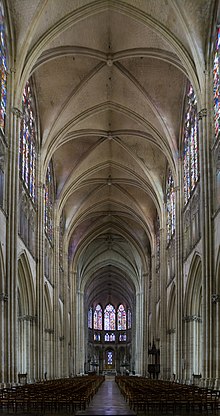Troyes is a city of 63,000 people (2021) on the Seine river in the Grand-Est region of France. The city has a rich architectural and urban heritage: many buildings are protected as historical monuments, including the half-timbered houses (mainly of the 16th century) that survived in the old town. They have contributed to Troyes being designated as a City of Art and History.
Understand
[edit]Troyes developed as early as the Roman era, when it was known as Augustobona Tricassium. It stood at the hub of numerous highways, primarily the Via Agrippa.
Manufacturing of textiles, developed from the 18th century onwards, was a chief part of Troyes' economy until the 1960s. Today, Troyes is the European capital of factory outlets and trading.
Get in
[edit]Troyes sits on the Seine river about 140 km (87 mi) south-east of Paris. Troyes is within the Champagne wine region and is near the Orient Forest Regional Natural Park.
The train station Gare de Troyes has connections from Paris, Dijon, Mulhouse and several regional destinations.
Troyes is at the junction of motorways A5 (Paris – Troyes – Langres) and A26 (Calais – Reims – Troyes). Troyes – Barberey Airport is a small regional airport.
Get around
[edit]See
[edit]
- 1 Troyes Cathedral (Cathédrale Saint-Pierre-et-Saint-Paul de Troyes). The cathedral, in the Gothic architectural style, has been a listed monument historique since 1862.

- Many half-timbered houses (mainly of the 16th century) survive in the old town.
- Hôtels particuliers (mansions) of the old town
- The Hôtel de Ville, Place Alexandre Israël, is an urbane example of the style Louis XIII. On the central corps de logis, which contains the main reception rooms, its cornice is rhythmically broken forward over paired Corinthian columns; these are supported below by strong clustered pilasters. Above the entrance door the statue of Louis XIV was pulled out of its niche and smashed in 1793, during the Reign of Terror at the height of the French Revolution; it was replaced in the nineteenth century with the present Helmeted Minerva and the device in its original form. It is now rare to see "Liberté, Egalité, Fraternité, ou la Mort". In the Salle du Conseil (Council Chamber) a marble medallion of Louis XIV (1690) by François Girardon, born at Troyes, survived the destruction unscathed.
Further afield
[edit]- 2 Charles de Gaulle Memorial (Colombey-les-Deux-Églises, 20 km from junction 23 of the A5, 90 km east of Troyes), ☏ +33 3 25 30 90 80. Closed Jan; Feb–Apr: W-M 10:00–17:30 (closed Tu); May–Sep: daily 09:30–19:00; Oct–Dec: W-M 10:00–17:30 (closed Tu). France's national memorial to its great leader and statesman is at his former home and burial place. The memorial is a gigantic patriarchal cross which dominates the surrounding countryside. Also onsite is a museum which charts General de Gaulle's life, from his role in the Allied war effort and liberation of France, to leading his country into its economic golden era and the foundation of the Fifth Republic. Adult €13.50, concession €11, child (6-12) €8; child (under 6) free.
Do
[edit]
- Football: Troyes AC were relegated in 2023 and again in 2024 so they now play soccer in Championnat National, the third tier. Their home ground Stade de l'Aube (capacity 20,400) is 1 km northeast of city centre.
Buy
[edit]Eat
[edit]- Auberge de Sainte Maure, 99, route de Méry, Sainte Maure (on the D78), ☏ +33 3 25 76 90 41, auberge.saintemaure@wanadoo.fr. Closed Sunday evening and Monday. Country inn with a clear dining room, and a terrace along the river for the summer. Fine cooking (gâteau de pied de cochon, ris d'agneau aux épices douces). Beautiful wine list. They also have three rooms. 2-course meal with wine €70.
- Hôtel restaurant du commerce, Bar-sur-Seine (32 km southeast), ☏ +33 3 25 86 36. A good brasserie, frequented by locals. Two-courses meal with wine €20.
Drink
[edit]Sleep
[edit]Connect
[edit]As of June 2022, Troyes has 4G from Bouygues and SFR, and 5G from Free and Orange.
Go next
[edit]


